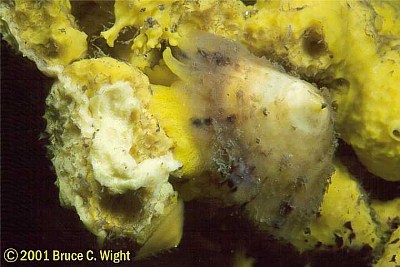
Tylodina fungina
Gabb, 1865
Order: NOTASPIDEA
Superfamily: TYLODINOIDEA
Family: Tylodinidae
DISTRIBUTION
Southern California to the Galapagos Ids.
PHOTO
Shaw's Cove, Laguna Beach, California, 15-20 feet. UPPER: Two animals on its food, the yellow sulfur sponge, Aplysina fistularis. LOWER LEFT: adult. LOWER RIGHT: juvenile. PHOTOS: Bruce Wight.
Feeds exclusively on the sponge Aplysina fistularis.
See T. corticalis and T. perversum.
Reference:
• Gabb, W.M. (1865) Description of new species of marine shells from the coast of California. Proceedings of the California Academy of Science, 3: 182-190.
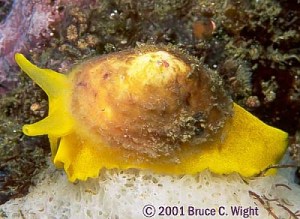
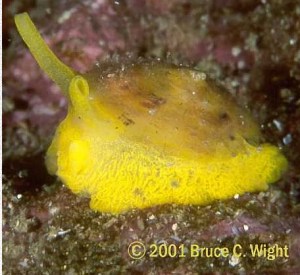
Rudman, W.B., 2001 (February 2) Tylodina fungina Gabb, 1865. [In] Sea Slug Forum. Australian Museum, Sydney. Available from http://www.seaslugforum.net/find/tylofung
Related messages
Re: Tylodina fungina
June 5, 2006
From: Kevin Lee
Concerning message #16755:
Thanks for your last message and comments, Doc...
Yes, when my buddy and I spotted the three-incher, we both had to rub our eyes and blink twice. The T. fungina seemed gargantuan, compared to the much smaller specimens, we normally see in local waters. As a rough gauge, I took off my dive glove & placed my index finger next to the slug, confirming that it easily measured 3 inches. It was strange to see the animal crawling on the pebbly bottom, until we looked up, and saw that it had most likely fallen from the copious growth of yellow sponge, growing on the archway ceiling of the large swim-thru we were in. In other words, it was quite well-nourished. BTW, I now dive more frequently, with a stainless steel rule, to more accurately document these events.
K:-)
diverkevin@gmail.com
Kevin Lee, 2006 (Jun 5) Re: Tylodina fungina. [Message in] Sea Slug Forum. Australian Museum, Sydney. Available from http://www.seaslugforum.net/find/16762Dear Kevin,
Thanks for that. It's an interesting observation. It is a similar story with our local southern Australian Tylodina, T. corticalis, which is usually about 15-20 mm in length but every now and then a monster appears. I am posting some messages on that species today [see #16799, #16801, #16800] to show of the size and shell-shape varability in that species.
Best wishes,
Bill Rudman
Re: Tylodina fungina
June 1, 2006
From: Kevin Lee
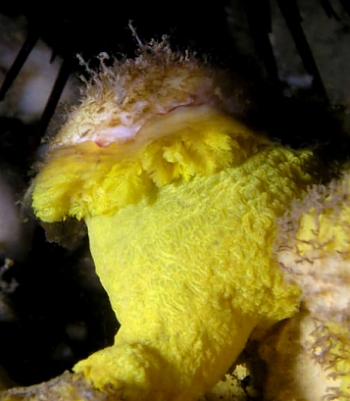
Concerning message #16722:
Hi again, Doc...
Many thanks for the taxonomic lesson. Somehow, my brain erroneously had the Tylodina fungina categorized as a nudibranch, up till now. Accuracy is important!
In reviewing my Mushroom Sidegill images, I have only one (rear shot) that really shows the branchial plume, truly on the side and under the shell. Also, another foto, which shows distinct "eyes". Normally, the eyes are not so readily observable. Do they fade out or get covered up as the animal matures?
Locality: Shaw's Cove, Laguna Beach, approx 20 feet, California, USA, Eastern Pacific, Upper: 09 FEB 2005. Lower: 07 MAY 2005, rocky reef substrate . Length: both approx. 1.5 inches. Photographer: Kevin Lee.
Really enjoying your site. Keep up the great work.
Best regards,
K:-)
diverkevin@gmail.com
Kevin Lee, 2006 (Jun 1) Re: Tylodina fungina. [Message in] Sea Slug Forum. Australian Museum, Sydney. Available from http://www.seaslugforum.net/find/16755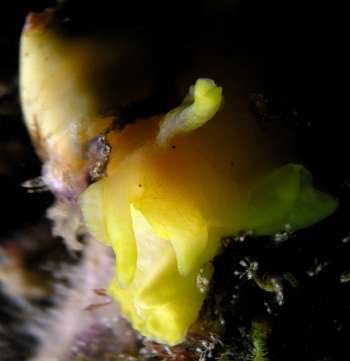
Dear Kevin,
There's no extra charge for the taxonomic lesson - using 'nudibranch' as a general name is a common mistake in usage which just becomes confusing. Accuracy is important, not for its own sake, but because scientific names are more than a simple 'label' to attach to a species, they are a guide to the evolutionary history and relationships of the species. A bit like family names [surnames] in some human societies. For example all true nudibranchs are carnivores, so if we find a nudibranch-looking animal, such as Stiliger aureomarginatus, feeding on algae, then we can be pretty sure it is not a nudibranch and is most probably a sacoglossan. Scientific names give us clues to the biology and natural history. For example all species of Tylodina feed on sponges in the Order Verongida, Family Aplysinellidae, so if you find a species of Tylodina, even a new one, you can make a fairly confident prediction that it will feed on an Aplysinellid sponge.
Concerning the eyes, I suspect its a question of magnification. In larger animals, the eyes will be proportionally smaller in your photos so less easy to see. In Jim Lyle's message #14710 there is a close-up shot of the head of a 3 cm long animal and the eyes are quite visible, and certainly in the species I am more familiar with, Tylodina corticalis, the eyes are quite obvious even in a 5 cm long animal.
In your last message you mention a length of 3 inches, which is about 75 mm, much larger than the 30 mm length mentioned by Behrens & Hermosillo (2005). It's always possible you have found some very large animals so it would be nice to confirm the measurements if possible.
Best wishes,
Bill Rudman
Tylodina fungina - variable shell shape
May 31, 2006
From: Kevin Lee
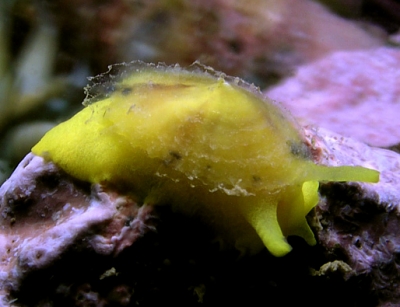
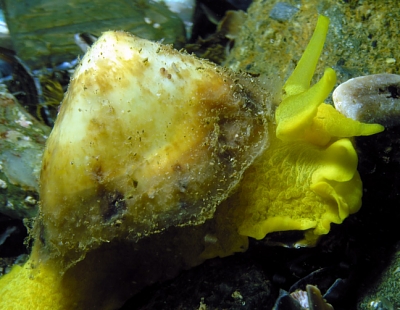
Hi Doc,
In reviewing some past images of the Tylodina fungina (Mushroom Sidegill), one of the few nudibranchs with an external shell, I was struck by the transparency of the juvenile shell. Thought our group might be interested. The juv measures about 0.75 inch in length; whereas, the adult is a whopping 3 inches! I've also included the nud, snugly enscounced in the yellow sponge on which it feeds.
Locality: Shaw's Cove, Laguna Beach, ranging from 15 to 20 feet, California, USA, Eastern Pacific, Upper photo: 06 Jan 2005 juv, Length: 0.75 inch; Middle photo: 14 Dec 2004 adult, 3.0 inch adult; Lower photo: 24 Dec 2004 on sponge, 1.5 inch. rocky reef substrate, Photographer: Kevin Lee.
K:-)
diverkevin@gmail.com
Kevin Lee, 2006 (May 31) Tylodina fungina - variable shell shape. [Message in] Sea Slug Forum. Australian Museum, Sydney. Available from http://www.seaslugforum.net/find/16722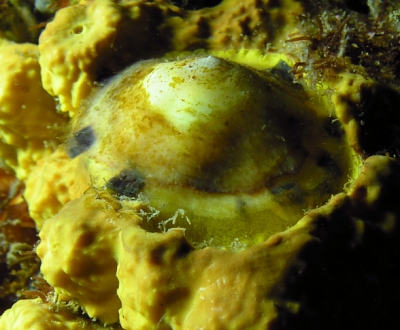
Dear Kevin,
Your photos certainly show quite a difference in shell shape and I firts wondered whether the juvenile was Anidolyta spongotheras (Bertsch, 1980), a related animal from your part of the world with more flattened shell. I am sure that Dave Behrens will let us know if I am wrong, but I think the animal in your photo is clearly that of Tylodina, and if you look at other photos on the Forum of this species, there is a gradual 'heightening' of the shell as it grows larger.
Thanks for the nice photo of it sitting on its food sponge, Aplysina fistularis. You describe it as 'one of the few nudibranchs with an external shell'. Unfortunately 'nudibranch' is often used to mean 'sea slug' which is not correct. The scientific word for sea slugs is opisthobranch. Nudibranchs are just one 'Order' of the opisthobranchs, some others being the cephalaspideans (bubble-shells etc), the sacoglossans, and the sea hares. The order Notaspidea (side-gilled slugs) is a bit of a problem at the moment because its seems the external shelled Tylodinoidea and the internal shelled Pleurobranchoidea are quite unrelated. For that matter, even the Tylodinidae and the Umbraculidae don't sit well together. Although problems like this are a nuisance for 'list makers', they do indicate that people are studying the group and finding out new things, which is good. So don't lose any sleep over it but it is better to use 'sea slugs' or 'opisthobranchs' as a general term.
Best wishes,
Bill Rudman
Re: Tylodina fungina from California
September 5, 2005
From: James Lyle
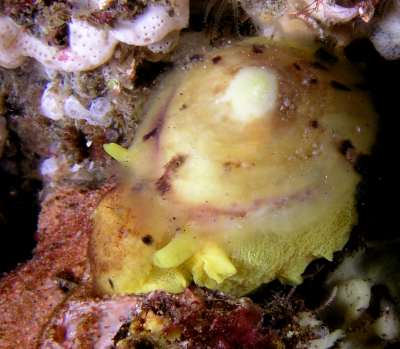
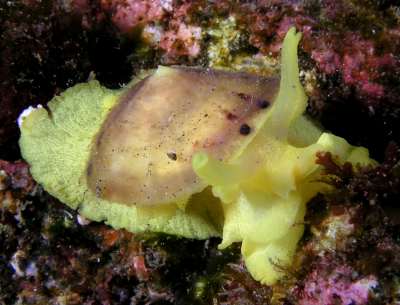
Dr. Rudman,
I'm sending you some high resolution images of Tylodinia fungina that I took on a recent dive near Anacapa Island, California. Prior to this dive, I had only observed one other small individual of this species. At Cathedral Cove, in 15 metres of water, on top of a rocky reef, I found three large (3 cm) animals, all within an area of one square metre.
Locality: Cathedral Cove, Anacapa Island, California, USA. Pacific Ocean.
Depth: 15 metres, Length: 3 cm. 01 September 2005. rocky reef. Photographer: Jim Lyle
I looked for, but didn't observe any yellow sulfur sponge (Aplysina fistularis), their reported food source. In one of the images, you can see the branch eating a sponge, but it isn't the characteristic colour of A. fistularis.
You can see the light yellow crescent shaped gland under the front of the shell that you commented on in Chris Grossman's pictures [#14432 ].
I find the pointillistic pigmentation to be interesting.
Best,
Jim Lyle
jlyle@scubadiving.com
Lyle, J.L., 2005 (Sep 5) Re: Tylodina fungina from California. [Message in] Sea Slug Forum. Australian Museum, Sydney. Available from http://www.seaslugforum.net/find/14710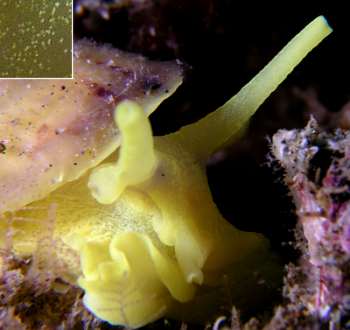
Dear Jim,
Thanks for the photos. Concerning the food sponge. I have no personal knowledge of Californian sponges but aome verongiids can have a dark brownish outer layer, as in this case, in fact the only way you know some of these sponges are yellow is to break them or have something bite them. The way the pigment is arranged in little spots is common to all species of Tylodina. The 'spots' may in fact be tiny glands or sacs storing defensive chemicals from the sponge. At times Tylodina can exude a thick whitish secretion from its skin which I have assumed comes from these little 'spots'.
Best wishes,
Bill Rudman
Tylodina fungina from California
July 29, 2005
From: Chris Grossman
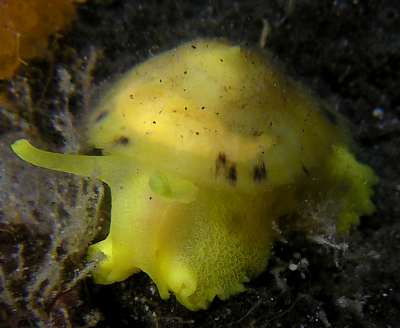
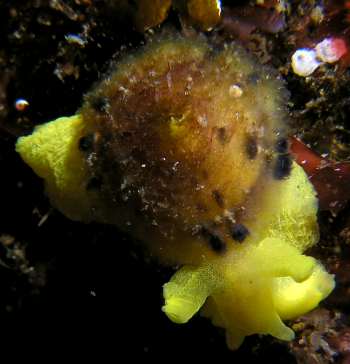
I took these pictures of Tylodina fungina on a two day trip. The first are from about 10 meters deep at Ship Rock, Catalina Island, California on July 15, 2005. I observed about 20 individuals in the area. However only two pictures came out well because of the surge and the fact that most were too deep in the rock crevices. They were about 2 cm in length [middle photo ].
The following day (July 16, 2005) at the East End reserve of Anacapa Island I found another lone example on a large rock at about 12 meters of depth. It was about 1.5 cm in length. However it was in a position to be easily photographed and there was almost no surge [upper and lower photos ].
Locality: Catalina & Anacapa Islands, California, USA. Depth: 10-12 m. Length: 1.5 to 2 cm. July 15-16, 2005. rocks with kelp. Photographer: Chris Grossman
Chris Grossman
seaslugforum.net@scubadiversnetwork.com
Grossman, P. C., 2005 (Jul 29) Tylodina fungina from California. [Message in] Sea Slug Forum. Australian Museum, Sydney. Available from http://www.seaslugforum.net/find/14432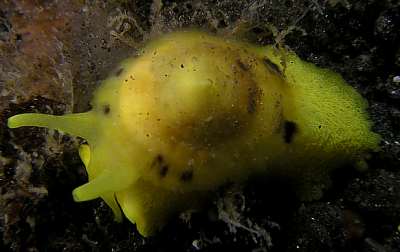
Dear Chris,
Thanks for these photos. They give us quite an interesting look at some of the external features of this primitive opisthobranch. Firstly it has a large, conical, limpet-shaped shell, and you can see the slightly recurved larval shell [protoconch] right at the tip. The shell is covered by a horny layer [periostracum] - all very snail-like for a slug! Tylodina has a pair of large enrolled head tentacles [rhinophores] like those found in the related pleurobranchs. It differs from its shelled relative, Umbraculum, in having a much more elongate body, and in having a 'snout' extending out from the front of the body. In Umbraculum, the mouth is at the bottom of a groove down the front of the circular body.
One interesting feature we can see in your upper photo, is a light yellow crescent shaped gland, at the front of the mantle, under the shell. This is almost certainly the same organ as the 'pre-mantle gland' reported by Burn (1960) from the Australian Tylodina corticalis. I can't find any reference to it being present in T. fungina.
-
Burn, R.F. (1960) On Tylodina corticalis, a rare opisthobranch from south-eastern Australia. Journal of the malacological Society of Australia, 1(4): 64-69.
Bill Rudman
Tylodina? from Monterey, CA
July 18, 2005
From: Clinton Bauder
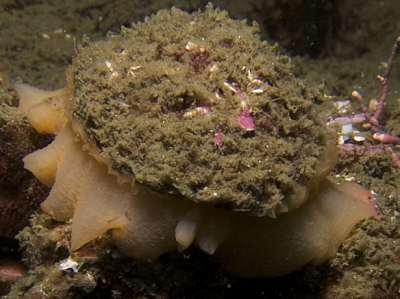
Hi Bill,
This is a bit of a mystery. Not sure if these are even an opisthobranch but this site seems as good a place as any to ask the question, especially as it does at the very least resemble a Tylodina. These two pictures are of different animals. The first which is the shot of the top of the animal was taken about a month ago and is a larger (40mm+) than the second shot which is maybe 20 mm. After failing to ID the animal the first time we were looking for it again on Saturday. I didn't find it until right as we were calling the dive but we at least had time for a picture of the underside of the animal. The depth was about 20 meters on the shale beds off of Del Monte Beach. The photograph was taken by my friend Mike Jimenez.
Locality: Monterey, California, USA. Depth: 20 meters. Length: 20-40 mm.
8 July 2005 Shale. Photographer: Mike Jimenez
Clinton
gecko1@apple.com
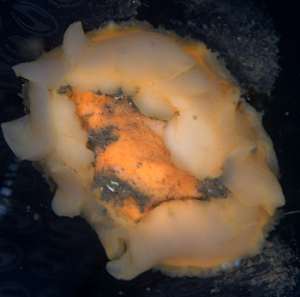
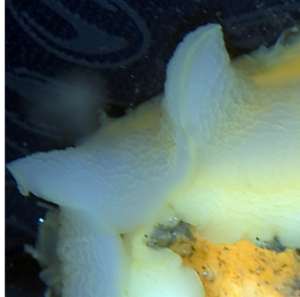
Dear Clinton,
You have every right to be puzzled. The top photo looks a bit like a Tylodina but the colour doesn't seem right and I can't see enough detail in the animal to be very confident. Similarly with the underside. What I can see doesn't look right but I can't see enough to make another suggestion. The shape of the strange 'head tentacles' reminds me of the marine pulmonate Trimusculus but hopefully someone with local knowledge will be able to solve this painlessly
Best wishes,
Bill Rudman
Tylodina fungina from Shaw's Cove
January 30, 2002
From: Bruce Wight
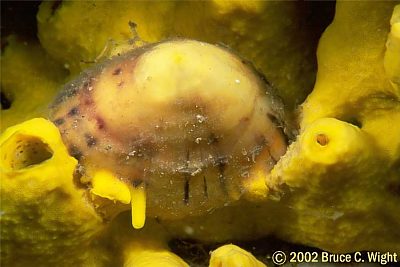
Hi Guys,
Here is a photo of Tylodina fungina on its food sponge from our recent dive [January, 2002] at Shaw's Cove in Laguna Beach [California].
Take care,
Bruce Wight
bwproductions@earthlink.net
Wight, B., 2002 (Jan 30) Tylodina fungina from Shaw's Cove. [Message in] Sea Slug Forum. Australian Museum, Sydney. Available from http://www.seaslugforum.net/find/6116Thanks Bruce,
Bill Rudman
Re: Tylodina fungina from California
February 5, 2001
From: Ron Velarde
Dr. Rudman,
Concerning your question about the sponge Tylodina feeds on. According to Morris et al. (1980), Aplysina fistularis (Pallas, 1766) is the correct name with Verongia aurea, Verongia thiona and Spongia fulva all being synonyms.
Morris, R.H., D.P. Abbott and E.C. Haderlie. 1980. Intertidal Invertebrates of California. Stanford University Press, Stanford, California. 690 pgs.
Again, thank you so much for all you do to keep us all informed on these magnificent animals!
Ron Velarde
rgv@sdcity.sannet.gov
Velarde, R., 2001 (Feb 5) Re: Tylodina fungina from California. [Message in] Sea Slug Forum. Australian Museum, Sydney. Available from http://www.seaslugforum.net/find/3702Thanks Ron,
Bill Rudman
Tylodina fungina food
February 5, 2001
From: Bruce Wight
Doc,
Concerning your question about the yellow sponge on which the Tylodina is feeding. It was previously known as Verongia aurea but is now Aplysina fistularis. See Daniel Gotshall's book (1994) Guide to Marine Invertebrates.
Bruce Wight
bwproductions@earthlink.net
Wight, B., 2001 (Feb 5) Tylodina fungina food. [Message in] Sea Slug Forum. Australian Museum, Sydney. Available from http://www.seaslugforum.net/find/3708Thanks Bruce,
Thought I should check this out. Sponge taxonomists are quite rare and so checking for the appropriate name is sometimes quite difficult.
Bill Rudman.
Tylodina fungina from California
February 3, 2001
From: Bruce Wight

Hi Doc,
Here is another opisthobranch, Tylodina fungina, from the Southern California area. The UPPER photo is of it on its food, the yellow sulfur sponge, Aplysina fistularis. The LOWER LEFT photo is of an adult and the LOWER RIGHT is of a juvenile. This species is very common and the shots were all taken in 15-20 feet of
water at Shaw's Cove in Laguna Beach.
Hope you enjoy these and they are of some benefit to your web site.
Take care,
Bruce Wight
bwproductions@earthlink.net


Dear Bruce,
Thanks very much for these interesting photos of Tylodina. Thanks also for the other photos which I will post in a few days.
Can someone please help with the sponge name. Bruce identifies it as Aplysina fistularis and Dave Behrens has Verongia thiona. I assume this is the same sponge? Can someone please give me the currently accepted name.
Bill Rudman
